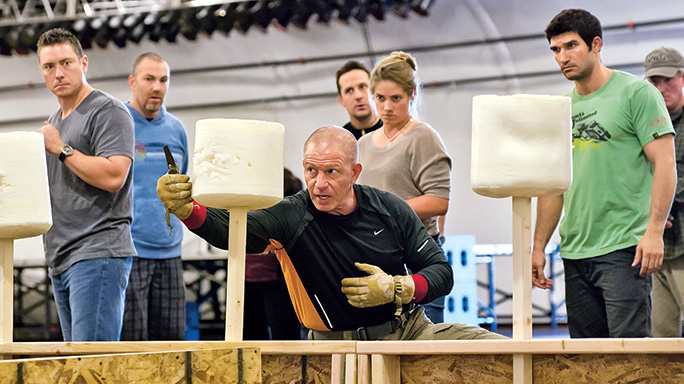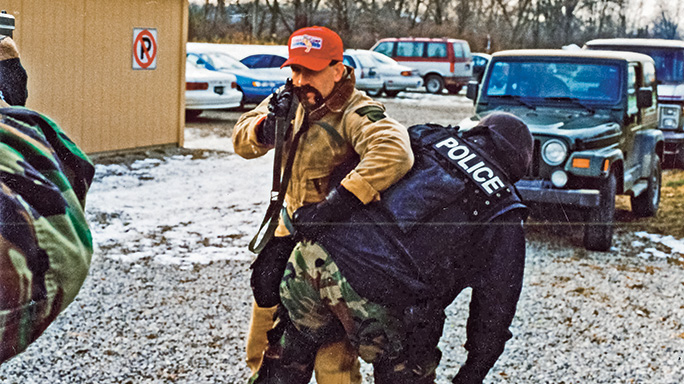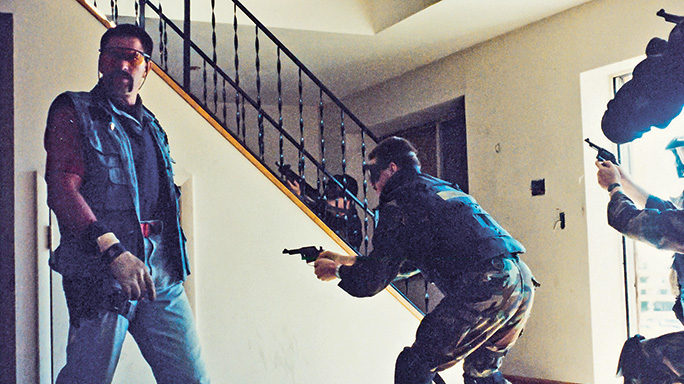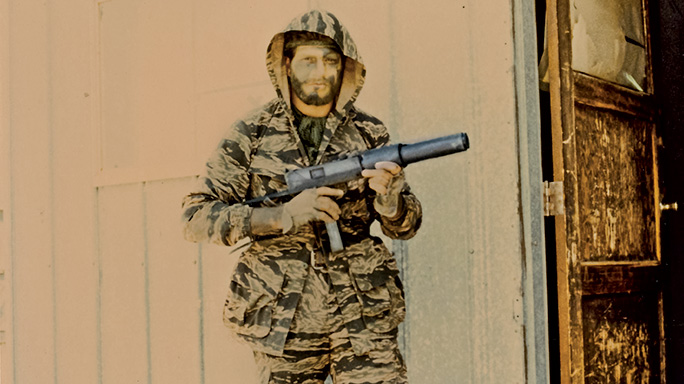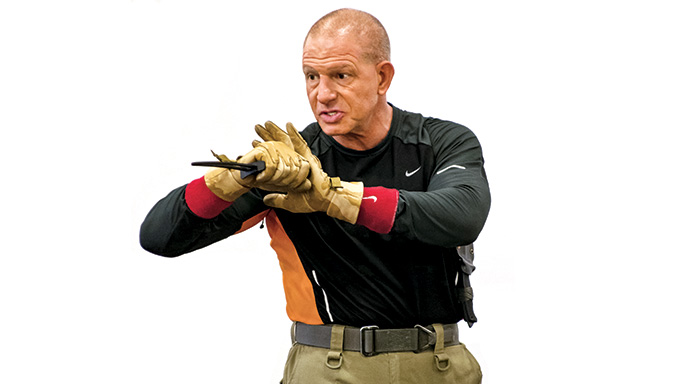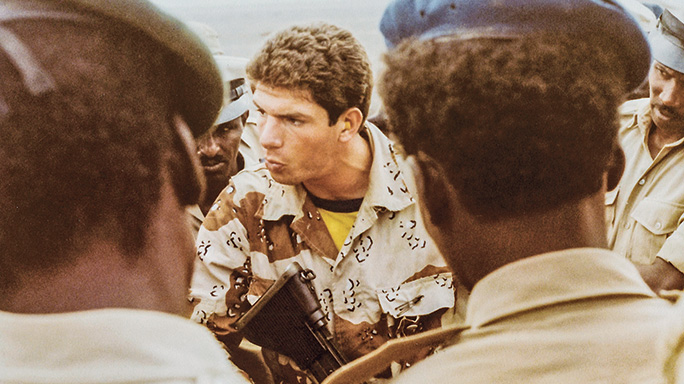Over the last decade, the U.S. Naval Special Warfare Development Group (DEVGRU) has become known as a go-to unit for sensitive, high-risk operations, including the successful raid on Osama bin Laden and the rescue of Captain Phillips from Somali pirates. The team is made up of older and more seasoned warriors who are chosen from the ranks of fellow SEALs.
- RELATED STORY: Gunfighting: How to Properly Reload Under Fire
Out of all the individuals that have ever earned the SEAL trident, less than one percent are ever actually invited to try and join DEVGRU, originally known as SEAL Team Six. One of those individuals is former DEVGRU member Chris Caracci, who was invited to join the team by its founder, retired Commander Dick Marcinko.
Becoming A SEAL
Advertisement — Continue Reading Below
“Growing up in Upstate New York, swimming in the ocean was the furthest thing from my mind,” said Chris Caracci. Caracci is one of those individuals who exudes the intensity and focus you may expect from someone who went through the extraordinary effort to become a SEAL—yet his path to a Navy Special Warfare Trident probably mirrors that of many other SEALs. “My father was a Marine in the Korean War, so the military was well known to me. I played lacrosse and wrestled in high school, and I enjoyed rough physical play and competitiveness.”
Caracci earned a lacrosse scholarship to Bowling Green State University. “I figured I’d go there, play lacrosse and enroll in the Air Force ROTC until I talked to my brother. He had been attending The Citadel in South Carolina and had done extensive research on America’s special operations community. A handyman he met in his hometown before leaving for college was actually a Vietnam UDT ‘frogman,’ and his stories grabbed my brother’s interest. In his junior year at The Citadel, he left, joined the Navy and went to Basic Underwater Demolition/ SEAL (BUD/S) school.
“I talked to my brother while he was attending BUD/S, and all the stuff he was doing sounded fascinating and just plain cool, so when I graduated high school in 1979, I scratched college and joined the Navy. In those days a smart move was to have a rating [job], so I enlisted as a gunner’s mate, which handles all sorts of weapons and weapon systems onboard ships, but I was also guaranteed a shot at attending BUD/S.”
Advertisement — Continue Reading Below
BUD/S Training
“BUD/S was so unique in that everything you did was called an ‘evolution,’ because no matter what block of training you completed, you were changed—you evolved,” said Caracci. “BUD/S had its challenges, but overall, I was prepared for the physical fitness. The pressure was that at any point, a failure to perform could mean dismissal from BUD/S and being thrown back into the fleet. What usually separated those who made it from those who didn’t was the will to win.”
“Hell Week is the ultimate physical test. This is five and a half days of little sleep and intense physical training. This is where candidates often break and, outside of an injury, only the truly committed survive,” said Caracci. “If you survive, then there’s drown proofing in the second dive phase, the jewel of this part of the training and something unique to SEAL training. Then in the third and final phase you move into land warfare. The third phase is when candidates become introduced to our basic weapon systems and basic demolition.”
Advertisement — Continue Reading Below
In reality, SEALs have and continue to be able to acquire, build and use any weapon they need. The main point of weapons training was to become, according to Caracci, “disciplined shooters that hit what we aim at, conserve ammo, know our targets and only shoot if we have a target.”
A Young SEAL
“When I finished BUD/S, there were only two teams: SEAL Team One on the West Coast and SEAL Team Two on the East Coast,” Caracci said. “I was assigned to Team One and in the entryway, on the quarter deck, was a column with the citations of our three SEALs that had earned the Congressional Medal of Honor. I knew right then that I was with some very special people.”
Advertisement — Continue Reading Below
Caracci continued, “I was very fortunate because many Vietnam-era frogmen were still around, including my first Officer in Charge Lt. R.J. Thomas, who in Vietnam was shot down in a helicopter three separate times. R.J. received the Navy Cross for rescuing the crew in one of the downed choppers. It was men like him and so many others that first taught me to be a frogman.
“SEALs are empowered to think outside the box. I had wrestled and taken traditional karate most of my life, and the SEALs afforded me the opportunity to train throughout Asia. This allowed me to help develop a multi-disciplined fighting style, long before the MMA craze swept the nation,” Caracci said.
“This knowledge became critical in helping me create ‘alternative force’ tactics for SEALs and later, law enforcement. At the time, these tactics were germane to SEAL Team Six because of its primary hostage-rescue mission. These techniques allowed us to use both less-lethal and lethal force seamlessly depending on the threat we encountered.”
Advertisement — Continue Reading Below
SEAL Team Six
SEAL Team Six was formed in the aftermath of the Iranian hostage crisis. When the rescue attempt, Operation Eagle Claw, failed, Commander Dick Marcinko was tasked with creating a new anti-terror team for the U.S. Navy with the goal of saving potential hostages in the future. “SEAL Team Six was unique in that it tried to blend every capability into one functional unit. This way they didn’t have to rely on anyone else—and I loved the mission,” said Caracci.
At that time, “assignment to SEAL Team Six was generally reserved for our best, top one percent. It was mostly Vietnam vets, and if you were too young, you just had to be damned good. Fortunately, SEAL Team One already had a contingent anti-terrorist platoon, and even as a young SEAL I had developed a good reputation as an operator. When Commander Marcinko drew men for SEAL Team Six, he took many from this Team One platoon. This, along with Marcinko’s ability to judge talent, allowed me this rare opportunity, which I’ll always be eternally grateful for.
Advertisement — Continue Reading Below
“At Team Six the missions were different, and the weapons would change with each mission. As an example, we needed to quietly be able to take out a threat 500 yards away, but at that time, suppressors were still in the works, so they found a gigantic crossbow. That was the great part about SEALs and specifically Team Six: You were allowed to think outside the box and problem solve—you weren’t confined with your creativity. I loved the mindset of solving problems instead of letting them become obstacles.”
Tactical Mindset
It was time for Caracci to leave the Navy when “I saw another war, one that I could enter that was taking place on the streets of America—the cocaine wars. I thought I could make a difference and decided to pursue a career in law enforcement.”
Advertisement — Continue Reading Below
In the early 1980s, the war on drugs was in full swing. Caracci initially started his law enforcement career in New Jersey, working narcotics for the Middlesex County Prosecutor’s Office. Eventually he relocated to Florida and was hired by the Ft. Lauderdale Police Department. “In Ft Lauderdale, I was quickly moved from patrol duties to their Tactical IMPACT Unit and SWAT team. This is where I put a lot of my SEAL training to use both on the street and in training other officers with alternative force methods,” said Caracci.
- RELATED VIDEO: Carbine Sling Essentials with Pat McNamara
“In law enforcement, I was able to combine my SEAL training, martial arts background and dedication to protecting the American people. Truth be told, law enforcement was like a laboratory for me, as I got to use much of what I learned with the SEALs. To this day, even in private security, I am committed to ensuring our nation’s law enforcement officers are well trained with the most practical, up-to-date tactics. I’ve seen too many officers in bad situations due in large part to poor training and tactics. A tactical mindset along with proper tactics is key, and what I try to instill to whomever I’ve been asked to teach is the SEAL mindset: ‘If you never quit, you will never know how to.’”
